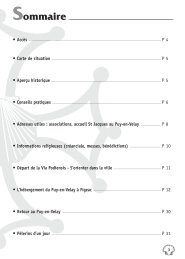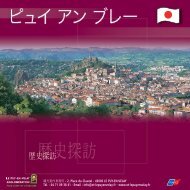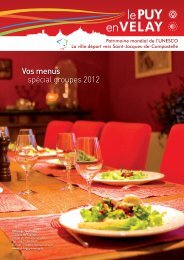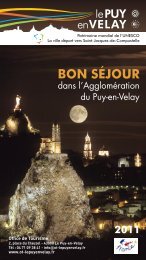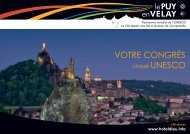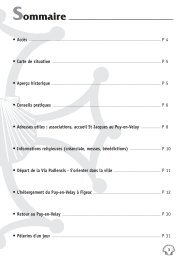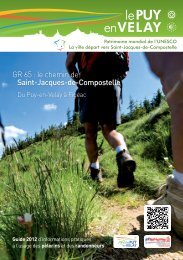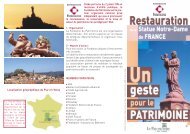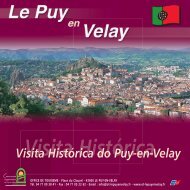Guide "Anglais":Guide "Anglais" - Le Puy-en-Velay
Guide "Anglais":Guide "Anglais" - Le Puy-en-Velay
Guide "Anglais":Guide "Anglais" - Le Puy-en-Velay
You also want an ePaper? Increase the reach of your titles
YUMPU automatically turns print PDFs into web optimized ePapers that Google loves.
Historical visit<br />
Historical visit<br />
OFFICE DE TOURISME - Place du Clauzel - 43000 LE PUY-EN-VELAY<br />
Tél. 04 71 09 38 41 - Fax : 04 71 05 22 62 - Email : info@ot-lepuy<strong>en</strong>velay.fr - www.ot-lepuy<strong>en</strong>velay.fr
Historical town visit of <strong>Le</strong> <strong>Puy</strong>-<strong>en</strong>-<strong>Velay</strong><br />
Starting at the place du Breuil, cross the<br />
boulevard du Breuil, go down rue Porte-Aiguière<br />
and stop at number 16 where you can see where<br />
the former town wall once stood. It was built in<br />
the 13th c<strong>en</strong>tury and demolished in 1782. The<br />
main roads of the modern town (boulevard Carnot,<br />
boulevard Saint-Louis, boulevard du Breuil,<br />
boulevard Maréchal-Fayolle and the faubourg<br />
Saint-Jean) follow the lines of the former<br />
ramparts.<br />
1 PLACE DU MARTOURET<br />
From the late Latin "martoretum", cemetery; this<br />
name has popularly tak<strong>en</strong> on the meaning of<br />
"the square of the martyrs" because the site was<br />
reserved for public executions; it was also here<br />
on 8th June 1794 that the original miraculous<br />
statue of the Black Virgin was set on fire and<br />
destroyed.<br />
Throughout the Fr<strong>en</strong>ch Revolution the guillotine<br />
stood perman<strong>en</strong>tly on this site from 30th March<br />
1793. From this date until January 1795,<br />
41 executions took place.<br />
On the left-hand side of the square stands the<br />
town hall. 2 This building was completed in<br />
1766, designed by the architect Portal in Louis<br />
XV style, with a classical façade. It was built on<br />
the site of the former “consulate”(the “consuls”<br />
were the former town-councillors), and was<br />
destroyed on several occasions by viol<strong>en</strong>t fires<br />
(in 1817 and 1964).<br />
Tourist<br />
3 PLACE DU CLAUZEL Office<br />
In the Occitan language, the term "clauzel"<br />
meant a small courtyard. The site used to be a<br />
cemetery for the burial of paupers from the<br />
Hôtel Dieu. It ceased to be used for this purpose<br />
in 1654. The local flea market is now held here<br />
on Saturday mornings.<br />
4 RUE COURRERIE<br />
(formerly known as the street of Curriers). At<br />
number 6, a R<strong>en</strong>aissance house faces the street<br />
with three arches decorated with grotesques.<br />
Notice the inner courtyard and tower dating from<br />
1571. At number 8, check out the 16th c<strong>en</strong>tury<br />
façade.<br />
5 PLACE DU PLOT<br />
In 1548 the consuls set up a pillory on the square<br />
for drunkards, so that passers-by could laugh at<br />
them.<br />
The fountain, known as the "Bidoire", is the<br />
oldest in the town, installed in 1246.<br />
The dolphins and eagles decorating it probably<br />
date from the 15th c<strong>en</strong>tury. From the 10th<br />
c<strong>en</strong>tury to the beginning of the 19th c<strong>en</strong>tury the<br />
church of St Pierre du Monastier stood on the<br />
east side of the square.<br />
On Saturday mornings the picturesque weekly<br />
market is held here. They sell a particularly tasty<br />
local cheese covered with hundreds of microorganisms<br />
(artisons) which <strong>en</strong>sure its distinct<br />
quality.<br />
Farm cheese from the <strong>Velay</strong> is m<strong>en</strong>tioned in the<br />
"Larousse des fromages".<br />
The place du Plot is the starting point for<br />
pilgrimages to Santiago de Compostela (The via<br />
podi<strong>en</strong>sis GR65).<br />
In the rue St Gilles, you are at the starting<br />
point for the “voie Régordane” for pilgrims<br />
going to St Gilles du Gard.<br />
6 RUE PANNESSAC<br />
(formerly the rue du Commerce des Grains).<br />
There are still many houses dating from the<br />
15th to the 18th c<strong>en</strong>turies here. Number 16 still<br />
has a 15th c<strong>en</strong>tury corbelled tower overlooking<br />
the rue Philibert 7 .<br />
7 bis RUE CHAMARLENC<br />
At n° 18 you can find the<br />
headquarters of the former<br />
Cornards fraternity. Take a<br />
look at the two masks.<br />
8 RUE CHENEBOUTERIE<br />
(formerly the street of the<br />
hemp merchants)<br />
At number 6 you can see the<br />
house of a 16th c<strong>en</strong>tury spice<br />
seller. It is known as the house of the "cagaïre"<br />
due to the amusing scatological sculpture on its<br />
façade.<br />
Other houses merit closer att<strong>en</strong>tion, i.e.<br />
numbers 10, 12, 14 and 17, and number 9,<br />
which dates from 1592 and is the birthplace of<br />
Marshall Fayolle. He was a G<strong>en</strong>eral at the <strong>en</strong>d of<br />
the First World War; he commanded the Fr<strong>en</strong>ch<br />
army in Italy in 1917 and participated in the<br />
victory of the Fr<strong>en</strong>ch front line in the decisive<br />
attack of 1918.<br />
From the rue Chènebouterie we set off up the<br />
picturesque steep streets on the fifte<strong>en</strong>c<strong>en</strong>turies-old<br />
pilgrimage to the Virgin of <strong>Le</strong> <strong>Puy</strong><strong>en</strong>-<strong>Velay</strong>,<br />
up to Mount Anis. Still today, after the<br />
gathering of faithful worshippers and pilgrims in<br />
the place du Plot, this is the starting point for<br />
the deeply moving annual torchlight procession<br />
on 14th August at 8.45 pm.<br />
9 RUE RAPHAEL<br />
Once occupied by middle-class families and<br />
leading citiz<strong>en</strong>s of the town. At number 38 you<br />
can see a video on bobbin lace-making at The<br />
Bobbin Lace Teaching C<strong>en</strong>tre, and also visit an<br />
exhibition of antique and contemporary lace.<br />
At number 56 a R<strong>en</strong>aissance façade, with small<br />
Corinthian columns, supports on the first floor a<br />
frieze decorated with masks of the sun and the<br />
moon.<br />
3
4<br />
10 PLACE DES TABLES<br />
Maison Breymand (15th and 16th c<strong>en</strong>tury). The<br />
windows on the façade show the change from<br />
gothic style on the first floor to R<strong>en</strong>aissance on<br />
the second and third floors.<br />
The so-called "choriste" fountain : in the 15th<br />
c<strong>en</strong>tury the fountain was dedicated to the<br />
memory of a young chorister who sang religious<br />
songs in the streets in this area of <strong>Le</strong> <strong>Puy</strong> at<br />
Christmas time. Until 1803, the fountain stood in<br />
the rue des Farges 11 (formerly the blacksmiths'<br />
and ironmongers' area).<br />
12 RUE DES TABLES<br />
This street is called the "street of tables" simply<br />
because on religious holidays traders from the<br />
town used to set up here their "tables" selling<br />
religious objects to pilgrims.<br />
13 RUE BECDELIEVRE<br />
Viscount Becdelièvre was the founder of the museum<br />
at <strong>Le</strong> <strong>Puy</strong>. The house of the Coquery dates from the<br />
15th c<strong>en</strong>tury. It is also worth noticing the<br />
<strong>en</strong>trances of numbers 5, 7 and 12. Th<strong>en</strong> cross in<br />
front of the former G<strong>en</strong>eral Hospital, which is now<br />
the "Hôtel du Départem<strong>en</strong>t", remarkably well<br />
restored by the architect Jean-Michel Vilmotte. Just<br />
a few steps on, you will see the former porte<br />
Gouteyron 14 , which already existed in 1295, and<br />
through which you can see the Aiguilhe rock and<br />
the chapel of St Michael.<br />
15 THE CATHEDRAL<br />
(A UNESCO World Heritage site)<br />
The rue des Tables leads to the foot of the main<br />
steps up to the<br />
Cathedral (134<br />
steps). From its<br />
origins until our own<br />
day, pilgrimage to<br />
Notre-Dame du <strong>Puy</strong><br />
has contributed to<br />
the developm<strong>en</strong>t and<br />
prosperity of the<br />
town. The Cathedral<br />
is Romanesque in<br />
style, but shows<br />
various influ<strong>en</strong>ces<br />
especially Bysantine<br />
ones.<br />
Under the main <strong>en</strong>trance, check out the "portes<br />
de cèdre" (the 12th c<strong>en</strong>tury cedar doors) and the<br />
internal staircase (sometimes op<strong>en</strong> in summer)<br />
the first steps of which can be se<strong>en</strong> under the<br />
nave. The choir area of the cathedral is built<br />
directly on the rock, but wh<strong>en</strong> the cathedral had<br />
to be <strong>en</strong>larged in the 11th and 12th c<strong>en</strong>turies in<br />
order to accommodate the increasing number of<br />
pilgrims, four additional bays were audaciously<br />
built over the void in order to comp<strong>en</strong>sate for the<br />
differ<strong>en</strong>ce in level of 17 metres. Several<br />
impressive pillars hold up the high arches.<br />
IN THE CATHEDRAL DON'T MISS :<br />
● THE FEVER STONE<br />
(or stone of apparitions). During the first<br />
c<strong>en</strong>turies of the Christian era, in Roman times,<br />
the Virgin appeared on Mount Anis. This flat<br />
volcanic stone has since be<strong>en</strong> known as the<br />
"Fever Stone" because of miraculous healing<br />
associated with it.<br />
Following a further apparition, the first church<br />
was built about 430 AD on the site indicated by<br />
the Virgin, which was also the site of a pagan<br />
sanctuary. Christian pilgrimages began from this<br />
time. With Chartres, <strong>Le</strong> <strong>Puy</strong>-<strong>en</strong>-<strong>Velay</strong> is the oldest<br />
sanctuary dedicated to Mary in Christian Gaul.<br />
At the time of the first Crusade in 1095 the<br />
Bishop of <strong>Le</strong> <strong>Puy</strong>, Adhémar de Monteil, was the<br />
legate of Pope Urban II. It is considered that he<br />
made popular the "Salve Regina", which<br />
St Bernard would later refer to as the <strong>Le</strong> <strong>Puy</strong><br />
antiphony.<br />
The importance of religious festivals<br />
Religious festivals always repres<strong>en</strong>t high points in<br />
the liturgical year. Every Maundy Thursday, after<br />
the ev<strong>en</strong>ing Mass commemorating the Last Supper,<br />
the White P<strong>en</strong>it<strong>en</strong>ts follow the Way of the Cross<br />
through the old town, meditating as they go, in<br />
memory of Christ's passion. On the ev<strong>en</strong>ing of the<br />
31st May, the feast of the Visitation, a torchlight<br />
procession walks up to the top of the Corneille<br />
Rock. These nocturnal pilgrims pay tribute to the<br />
charity of the Virgin Mary visiting her cousin<br />
Elizabeth. Lights will shine out again in the night<br />
of 14th August; on the eve of the feast of the<br />
Assumption, many people go up from the lower<br />
town to the sanctuary. The feast of the Assumption<br />
on 15th August culminates in the afternoon<br />
procession wh<strong>en</strong> the statue of the Black Virgin is<br />
carried through the town. Many other religious<br />
festivals are the occasion for processions, the most<br />
important certainly being the Jubilee. This occurs<br />
wh<strong>en</strong> 25th March, the feast of the Annunciation,<br />
coincides with Good Friday, so that the<br />
Incarnation coincides with the<br />
Redemption.<br />
The last Jubilees was in 2005 and the<br />
next one will take place in 2016.<br />
● NOTRE-DAME DU PUY :<br />
THE BLACK VIRGIN<br />
The statue (17th c<strong>en</strong>tury)<br />
which now stands on the<br />
high altar comes from the<br />
former chapel of St.<br />
Maurice du Refuge. It was<br />
crowned by the Bishop of<br />
<strong>Le</strong> <strong>Puy</strong> on behalf of Pope<br />
Pius IX on 8th June<br />
1856, the anniversary of<br />
the destruction of the previous effigy which<br />
was burned by the ultra-revolutionary groups of<br />
Louis Guyardin (repres<strong>en</strong>tative of the Conv<strong>en</strong>tion<br />
in Haute-Loire) on 8th June 1794. The 8th June<br />
was Whitsun Day, but under the Revolution was<br />
known as Supreme Being Day. The origin of the<br />
statue is not known; many hypothesis have be<strong>en</strong><br />
suggested. This statue was made of cedar.<br />
We only have a few repres<strong>en</strong>tations of this Black<br />
Virgin from a drawing made in 1777, ordered by<br />
the geologist Faugeas de St-Fons. But <strong>Le</strong> <strong>Puy</strong><br />
cathedral already had a statue of the Virgin long<br />
before the reign of Louis IX because its pres<strong>en</strong>ce<br />
is noted from the 10th c<strong>en</strong>tury onwards and,<br />
according to some authors, it could have served<br />
as a model for the first Virgins in Majesty of<br />
Auvergne.<br />
ALSO WORTH SEEING :<br />
● FRESCOES AND PAINTINGS<br />
In the north transept : "Holy wom<strong>en</strong> at the<br />
tomb", "The martyrdom of St Catherine of<br />
Alexandria" and on the upper level "The<br />
Archangel Michael",<br />
5.55 metres high.
● THE PLAGUE IN LE PUY<br />
There were 10,000 victims, as indicated by the<br />
local painter, Jean Solvain, in the painting<br />
repres<strong>en</strong>ting the procession of 1630 <strong>en</strong>titled "<strong>Le</strong><br />
voeu de la peste". Don't miss the sculptures in<br />
wood by Pierre Vaneau (1653-94) : The<br />
Assumption, the Martyrdom of St. Andrew, the<br />
pulpit and the organ case (17th c<strong>en</strong>tury). Notice<br />
in the third and fourth bays the two cupolas with<br />
supporting arches (squinches).<br />
● LIBERAL ARTS<br />
This wall-painting was discovered under a thick<br />
layer of whitewash in the Chapel of Relics in<br />
1850 by the writer, Prosper Mérimée, author of<br />
"Colomba" and "Carm<strong>en</strong>". He was authorised by<br />
the public authorities to carry out research on<br />
historical monum<strong>en</strong>ts. This painting is a<br />
masterpiece from the <strong>en</strong>d of the 15th c<strong>en</strong>tury and<br />
is strongly influ<strong>en</strong>ced by Flemish art. Grammar,<br />
Logic (Aristotle), Rhetoric (Cicero) and Music are<br />
repres<strong>en</strong>ted.<br />
● THE SACRISTY<br />
In the Sacristy there is a head of Christ from the<br />
15th c<strong>en</strong>tury, also photographic docum<strong>en</strong>tation<br />
on the bible of Théodulfe, a priceless item from<br />
the Treasury of the cathedral of <strong>Le</strong> <strong>Puy</strong> and a rare<br />
manuscript from the Carolingian period. Théodulfe<br />
(750 - 821), bishop of Orleans, is thought to<br />
have pres<strong>en</strong>ted his bible to the cathedral at <strong>Le</strong><br />
<strong>Puy</strong> in the course of a pilgrimage he made here in<br />
about 798.<br />
16 THE CHAPEL OF PENITENTS<br />
This chapel, which was established in 1584, is still<br />
op<strong>en</strong> for worship. It is a "small museum" with<br />
magnific<strong>en</strong>t paintings and sculptures.<br />
It has a remarkable R<strong>en</strong>aissance coffered ceiling<br />
with a c<strong>en</strong>tral design showing the Assumption of the<br />
Virgin.<br />
During the revolution the chapel was saved from<br />
desecration by the butchers' guild. Each year,<br />
butchers hold a service in memory of this ev<strong>en</strong>t. On<br />
the eve of Maundy Thursday a procession of White<br />
P<strong>en</strong>it<strong>en</strong>ts carrying the instrum<strong>en</strong>ts of the Passion is<br />
held in the streets of the upper town.<br />
17 THE CLOISTERS<br />
Listed as an historic monum<strong>en</strong>t and constructed<br />
at the same time as the Cathedral (11th - 12th<br />
c<strong>en</strong>tury), they are amongst the most beautiful in<br />
Europe. Visit the museum of religious arts in the<br />
salle des Etats du <strong>Velay</strong> and the fresco of the<br />
crucifixion in the chapter house (early 13th<br />
c<strong>en</strong>tury).<br />
Emile Male, historian and academician, stated<br />
that the arches of these cloisters could be<br />
compared to those of the mosque of Cordoba<br />
because of their differ<strong>en</strong>t coloured stones<br />
alternating in the same joyful style.<br />
18 BAPTISTRY OF ST. JOHN<br />
The <strong>en</strong>trance and the lions are inspired by<br />
Lombard Art.<br />
Head back down the rue Saint-Georges, and<br />
make a quick stop at the Place du For 19 to<br />
admire the view over the town. On the right,<br />
the façade of the Bishop's Palace and Porche du<br />
For (12th c<strong>en</strong>tury) with op<strong>en</strong>work arches,<br />
capitals and the oldest stones in the cathedral<br />
complex. The tympanum and lintel of the socalled<br />
"papal door" are reminisc<strong>en</strong>t of the<br />
Roman style of the architect of the first<br />
building, Scutarius, who became bishop of <strong>Le</strong><br />
<strong>Puy</strong> and was later canonised.<br />
Inside, notice the lintel from the former pagan<br />
temple. It bears an inscription giving the<br />
names of a divinity whose worship must have<br />
be<strong>en</strong> celebrated on Mount Anis, and also that<br />
of an emperor deified by the Romans : Adidon<br />
and Augustus.<br />
Coming back to the rue Saint-Georges, you<br />
pass the chapel of the Seminary.<br />
The Seminary of <strong>Le</strong> <strong>Puy</strong> and that of St-Sulpice<br />
in Paris were founded by Abbot Jean-Jacques<br />
Olier (1608-1657), Abbot of Pébrac. The<br />
v<strong>en</strong>erable mother Agnès Galland, born in <strong>Le</strong><br />
<strong>Puy</strong> (1602-1634), a mystical Dominican,<br />
provided the spiritual inspiration for these<br />
designs. Her shrine is in Langeac in the<br />
conv<strong>en</strong>t of St Catherine of Si<strong>en</strong>a. She was<br />
beatified in Rome on 20th November 1994 by<br />
Pope John Paul II.<br />
We now reach<br />
20 RUE CARDINAL DE POLIGNAC<br />
Opposite the chapel of the Anne-Marie Martel<br />
school.<br />
Anne-Marie Martel (1664-1673), born in <strong>Le</strong> <strong>Puy</strong>,<br />
founded the congregation of the "Dames de<br />
l'Instruction" in 1668 and the "Béates", who<br />
helped the sick and organised village assemblies<br />
in the <strong>Velay</strong> to teach catechism and lace-making.<br />
Meeting in "couviges" (from the Latin "cum<br />
vicinis" : "with the neighbours"), up to 130,000<br />
lace-makers lived in the Haute-Loire in the<br />
middle of the 19th c<strong>en</strong>tury.<br />
The ev<strong>en</strong> numbers of this street include a<br />
succession of houses that are among the most<br />
spl<strong>en</strong>did in the upper town. Number 8, the former<br />
"hôtel" of the Polignac family from 1611 to the<br />
Revolution, has a 15th c<strong>en</strong>tury tower overlooking<br />
an inner courtyard. Cardinal Melchior de Polignac<br />
(1661-1741) was Archbishop of Auch, Fr<strong>en</strong>ch<br />
ambassador to Poland and repres<strong>en</strong>tative of the<br />
King in Rome and Holland. In 1713 he negotiated<br />
the treaty of Utrecht giving Philippe V (grandson<br />
of Louis XIV) the right to the throne of Spain. A<br />
writer and member of the "Académie des<br />
Sci<strong>en</strong>ces" and the "Académie des inscriptions et<br />
des belles lettres", the Cardinal was elected to<br />
Bossuet's seat in the " Académie<br />
Française".<br />
21 RUE<br />
ROCHETAILLADE<br />
("carved in the rock")<br />
Romanesque façades,<br />
particularly at number<br />
7, the oldest house in the<br />
town (13th c<strong>en</strong>tury).<br />
RUE DU BOUILLON<br />
The name refers to the charity<br />
founded in <strong>Le</strong> <strong>Puy</strong> by St-Jean-<br />
François-Régis, to help poor<br />
families by delivering meals to<br />
them. Today the Emmaüs<br />
community takes in the homeless<br />
for the night.<br />
5
6<br />
22 PLACE DE LA PLATRIERE<br />
(the former plaster quarry). Here you can see the<br />
site of the birthplace of the writer Jules Vallès,<br />
and the former Chapel of the Visitation, which<br />
was built betwe<strong>en</strong> 1652 and 1655, and where the<br />
Companions of Jehu were judged at the <strong>en</strong>d of<br />
the Revolution. The Companions of Jehu hunted<br />
down the Jacobins from January to June 1795 in<br />
the Lyons area. Of 114 who were accused,<br />
111 were acquitted. Three were condemned to<br />
death in March 1799, but the s<strong>en</strong>t<strong>en</strong>ces were<br />
never carried out, the prisoners having escaped<br />
thanks to local contacts.<br />
Jules Vallès (1832-1885) was a member of the<br />
Paris Commune in 1871. He escaped from the<br />
execution of the Communards against the "mur<br />
des fédérés" in the Père Lachaise cemetery in<br />
Paris and took refuge in London. He returned to<br />
Paris after the amnesty in 1883, relaunched his<br />
newspaper "<strong>Le</strong> cri du peuple" and finished his<br />
autobiographical trilogy - "Jacques Vingtras",<br />
("L'Enfant", "<strong>Le</strong> Bachelier" and "L'Insurgé").<br />
23 PIERRE-CARDINAL CENTRE<br />
RUE JULES-VALLES<br />
These buildings have be<strong>en</strong> remarkably well<br />
restored and are today the place where the local<br />
associations meet and also house the cultural<br />
c<strong>en</strong>tre, the confer<strong>en</strong>ce c<strong>en</strong>tre and the youth<br />
hostel.<br />
In the 18th c<strong>en</strong>tury the building was a conv<strong>en</strong>t<br />
of the Sisters of St Mary. In 1792, during the<br />
Revolution, it was turned into a barracks before<br />
becoming a museum from 1820 to 1851. The<br />
building bore the name of Mouton-Duvernet and<br />
served as a school from 1920 to 1976. G<strong>en</strong>eral<br />
Mouton-Duvernet, born in <strong>Le</strong> <strong>Puy</strong> in 1770, was<br />
shot in Lyons in 1816 for joining the Emperor<br />
Napoleon 1st on his return from Elba.<br />
The poet and troubadour, Pierre Cardinal<br />
(1180-1278) was one of the major literary tal<strong>en</strong>ts<br />
in the Occitan language. He was famous for the<br />
critical "sirv<strong>en</strong>tes" that he wrote. He lived to be<br />
almost a hundred.<br />
24 THE CONVENT OF ST CLAIRE<br />
This conv<strong>en</strong>t was founded in 1432 by St Colette<br />
of Corbie (1381-1447), reformer of the second<br />
order of St Francis, the Poor Clares, and by Clauda<br />
de Rousillon (Viscountess of Polignac).<br />
The chapel is op<strong>en</strong> to the public. The high walls<br />
of the conv<strong>en</strong>t overlook the picturesque streets of<br />
the area, known as "Pouzarot” 25 (short for<br />
"well of the rock").<br />
This is one of the oldest parts of the town.<br />
Rec<strong>en</strong>tly restored, the area has preserved its<br />
original charm.<br />
26<br />
THE COLLEGE CHURCH<br />
Formerly the chapel of the Jesuit school, it was<br />
built in 1605 by Martellange, a Jesuit architect.<br />
A beautiful example of baroque architecture, this<br />
is the first Jesuit church in France. There are<br />
handsome retables in the choir, the first four<br />
lateral chapels and the baptistery. Local artists<br />
have maintained the beauty of this church<br />
throughout the ages :<br />
■ the painter Guy François was responsible for<br />
the paintings in the choir and in the first two<br />
lateral chapels<br />
■ the sculptor Pierre Vaneau (1653-1694) was<br />
responsible for the pulpit,<br />
■ the Jesuit brother André Besqueut for the<br />
statue of St Jean-François-Régis (1928),<br />
■ the sculptor Philippe Kaeppelin for the modern<br />
altar (1984).<br />
ST. JEAN-FRANCOIS-REGIS<br />
In 1640 the parliam<strong>en</strong>t of Toulouse received a<br />
decree from King Louis XIII forbidding the<br />
wearing of lace in order to restrict its production<br />
- lace-makers were so numerous that it was<br />
difficult to find female domestic staff. Jean-<br />
François-Régis, who evangelised the <strong>Velay</strong> and<br />
Vivarais, was concerned about the fate of lacemakers,<br />
and calmed their fears by predicting the<br />
cancellation of the decree. It is ev<strong>en</strong> said that<br />
he asked the Jesuit missionaries to publicise <strong>Le</strong><br />
<strong>Puy</strong> lace on their travels, thereby <strong>en</strong>suring its<br />
international success. He is still v<strong>en</strong>erated by<br />
lace-makers, and became their patron saint<br />
following his canonisation in 1737. His<br />
patronymic "Régis" is now used as a Christian<br />
name. The College church is now the starting<br />
point of the footpath "sur les pas de St-Régis"<br />
("the St Régis route") from <strong>Le</strong> <strong>Puy</strong>-<strong>en</strong>-<strong>Velay</strong> to La<br />
Louvesc (Ardèche).<br />
27 THE STATUE OF NOTRE-<br />
DAME DE FRANCE<br />
On 8th September 1855, the feastday<br />
of the Nativity of the Virgin<br />
Mary, G<strong>en</strong>eral Pélissier won victory<br />
at the siege of Sebastopol in the<br />
Crimean War. In gratitude he<br />
advised Bishop Mgr de Morlhon to<br />
ask the Emperor Napoleon III for<br />
some of the cannons captured<br />
from the <strong>en</strong>emy, in order to<br />
make a statue that the diocese<br />
of <strong>Le</strong> <strong>Puy</strong> wished to dedicate<br />
to Notre-Dame de France.<br />
Sculpted by Jean-Marie<br />
Bonnassieux, the statue is<br />
made of cast iron from the 213 canons from<br />
Sebastopol. It was inaugurated on 12th<br />
September 1860 in the pres<strong>en</strong>ce of 120,000<br />
pilgrims. The statue is 16 metres high (22.7m<br />
with the pedestal) and weighs 835 metric tonnes<br />
(110 tonnes for the statue, 680 the stone<br />
pedestal and 45 the iron coating).<br />
28 AIGUILHE, THE ROCK AND<br />
CHAPEL OF ST MICHAEL<br />
The rock, familiarly called "the dyke", is actually<br />
the v<strong>en</strong>t of a volcano, laid bare by erosion. The<br />
chapel on the top dates back to the 10th c<strong>en</strong>tury.<br />
In 950-951 Gothescalk, Bishop of <strong>Le</strong> <strong>Puy</strong>, led the<br />
first Fr<strong>en</strong>ch pilgrimage to Santiago de Compostela.<br />
On his return, a<br />
chapel dedicated to<br />
St Michael was built<br />
on the volcanic rock<br />
of Aiguilhe. The<br />
chapel was finished<br />
in 962 and<br />
inaugurated on 18th<br />
July. Among the<br />
treasures found<br />
wh<strong>en</strong> the altar was<br />
restored in 1955 is<br />
a magnific<strong>en</strong>t<br />
reliquary figure of<br />
Christ, probably the<br />
work of the 10th<br />
c<strong>en</strong>tury Spanish<br />
school.
28 bis CHAPEL OF ST CLAIR<br />
Oft<strong>en</strong> called the "Temple of Diana", this building<br />
may be the former chapel of the hospital of the<br />
poor of St Nicholas of Aiguilhe. Note the lintel<br />
illustrating the phases of the moon around the<br />
sun, and the arcades with a background of<br />
diamond-shaped mosaics.<br />
29 CROZATIER MUSEUM<br />
The museum is located in the H<strong>en</strong>ri Vinay public<br />
gard<strong>en</strong> (called "the Horseshoe" because of its<br />
shape). It was built in the middle of the 19th<br />
c<strong>en</strong>tury by the architect Antoine Martin, thanks<br />
mainly to a large legacy from Charles Crozatier<br />
(1795-1855), who made plaster casts for artists<br />
in Paris.<br />
There are 5 galleries showing the various<br />
collections :<br />
On the ground floor, the Gallo-Roman collection<br />
comes mainly from excavations carried out during<br />
the 19th c<strong>en</strong>tury. The most interesting elem<strong>en</strong>ts<br />
were found in the surroundings of the cathedral<br />
and come from a building which previously<br />
occupied that site.<br />
The stone and sculpture section is mainly<br />
mediaeval. It is particularly rich in Romanesque<br />
sculptures, most of them from the cathedral or<br />
from religious and civil buildings which were<br />
destroyed in the 19th c<strong>en</strong>tury.<br />
The collection of objets d'art has fine examples<br />
from the mediaeval and R<strong>en</strong>aissance periods,<br />
including small sculptures and <strong>en</strong>amels.<br />
The sci<strong>en</strong>ce and technology collection comes from<br />
the donation of Alexandre Clair, who was a<br />
Parisian <strong>en</strong>gineer specialising in the making of<br />
small-scale models for education at the time of<br />
the Second Empire.<br />
You can also find some interesting collections<br />
about clock-making and the beginnings of the<br />
cartoon film with the inv<strong>en</strong>tion of the<br />
"praxinoscope" by Emile Reynaud in <strong>Le</strong> <strong>Puy</strong>-<strong>en</strong>-<br />
<strong>Velay</strong> in 1877.<br />
On the first floor, the ethnology collections are<br />
c<strong>en</strong>tred on craftsmanship in <strong>Le</strong> <strong>Puy</strong> and the <strong>Velay</strong>.<br />
They illustrate the importance of activities like<br />
bronze work, glassworking, printmaking, nuns'<br />
work and of course lace-making.<br />
On the second floor the Fine Arts collection is<br />
famous for its paintings of the Nordic schools<br />
from the 16th to the 18th c<strong>en</strong>turies. A room is<br />
devoted to the works of the François brothers and<br />
the local school of the 17th c<strong>en</strong>tury. The 19th<br />
c<strong>en</strong>tury is repres<strong>en</strong>ted by topographical views of<br />
the region and large paintings s<strong>en</strong>t by the Fr<strong>en</strong>ch<br />
State.<br />
And finally, on the third floor, you discover the<br />
natural history collections (zoology, mineralogy,<br />
and geology) which constituted the basis of the<br />
museum at the beginning of the 19th c<strong>en</strong>tury.<br />
The palaeontology collection consists of a set of<br />
fossils from the rich sites of Haute-Loire.<br />
30 PANNESSAC TOWER<br />
Formerly the royal <strong>en</strong>trance to the town (14th<br />
c<strong>en</strong>tury) and partly demolished in 1850 to wid<strong>en</strong><br />
the <strong>en</strong>trance to the street. The site of the<br />
destroyed tower is indicated by cobbles on the<br />
pavem<strong>en</strong>t. The Emperor Charlemagne and thirte<strong>en</strong><br />
Fr<strong>en</strong>ch kings have made the pilgrimage to <strong>Le</strong> <strong>Puy</strong>.<br />
In 1254 King Louis IX, returning from the<br />
crusades, completed the seal of <strong>Le</strong> <strong>Puy</strong> by<br />
granting the town the right to add gold fleurs-delys<br />
on a blue<br />
background to the<br />
flying eagle in silver.<br />
The last royal visit<br />
was that of Francis I<br />
in 1533, to fulfil the<br />
vow he had made<br />
wh<strong>en</strong> he was a<br />
prisoner in Madrid after<br />
his defeat at Pavia<br />
(1525).<br />
30 bis STATUE OF<br />
GENERAL LAFAYETTE<br />
(1757-1834). He was born at the castle of<br />
Chavaniac (40 km from <strong>Le</strong> <strong>Puy</strong>) and was a hero of<br />
American indep<strong>en</strong>d<strong>en</strong>ce and a major figure in the<br />
Fr<strong>en</strong>ch Revolution.<br />
31 CHURCH OF SAINT LAURENT<br />
Since 1221, this has be<strong>en</strong> the church of the order<br />
of Preaching Friars founded by St Dominic (1170-<br />
1221), who perhaps came to <strong>Le</strong> <strong>Puy</strong> in the last<br />
year of his life.<br />
In the choir, on the right, is the recumb<strong>en</strong>t effigy<br />
of Constable Bertrand Duguesclin, who died on<br />
13th July 1380, at the siege of Chateauneuf-de-<br />
Randon. His body was embalmed in <strong>Le</strong> <strong>Puy</strong> and<br />
his <strong>en</strong>trails were buried in the church of St<br />
Laur<strong>en</strong>t.<br />
The building was <strong>en</strong>larged in the 14th c<strong>en</strong>tury<br />
and remains one of the rare examples of Gothic<br />
architecture in the region. The roof collapsed in<br />
1525, the bell tower was destroyed by the<br />
Hugu<strong>en</strong>ots in 1562, and the roof collapsed once<br />
again in 1644.<br />
In 1750, the external buttresses were added.<br />
In 1966 cables were stretched betwe<strong>en</strong> the pillars<br />
to prev<strong>en</strong>t movem<strong>en</strong>t. The church was closed to<br />
the public on 24th August 1971; consolidation,<br />
and th<strong>en</strong> restoration, were to take a long time,<br />
and the church was only reop<strong>en</strong>ed for worship for<br />
the Christmas service in 1988. In addition to the<br />
outstanding beauty of the architecture you can<br />
admire the perfectly restored 19th c<strong>en</strong>tury<br />
stained glass windows as well as those which<br />
have rec<strong>en</strong>tly be<strong>en</strong> created (the chapel of the<br />
Holy Sacram<strong>en</strong>t and the rose window in the<br />
façade) magnific<strong>en</strong>t woodwork (pulpit, stalls etc),<br />
pictures by Guy François, including the remarkable<br />
"Doubting Thomas", and the highly symbolic<br />
paving throughout the church.<br />
7
Docum<strong>en</strong>t édité par lʼOffice de Tourisme de lʼAgglomération du <strong>Puy</strong>-<strong>en</strong>-<strong>Velay</strong> - 01/07 - Photos : Office de Tourisme - Musée Crozatier - G. Cavaillès - L. Olivier - B. Galland<br />
“Standard<br />
tour"<br />
Itinerary :<br />
2 hours<br />
“Grand Tour”<br />
Itinerary :<br />
3 hours<br />
30<br />
Tour<br />
PANNESSAC<br />
30<br />
Statue<br />
Lafayette<br />
bis<br />
11<br />
5<br />
10<br />
6<br />
9<br />
1<br />
7<br />
8<br />
2<br />
4<br />
12<br />
21<br />
3<br />
13<br />
14<br />
17<br />
28 et 28<br />
22<br />
15<br />
16<br />
bis<br />
vers Rocher<br />
St-Michel<br />
Eglise<br />
Saint-Laur<strong>en</strong>t<br />
31<br />
Av. de la Cathédrale<br />
Porte<br />
Gouteyron<br />
Conseil<br />
Général<br />
Cathédrale<br />
18<br />
20<br />
Chapelle<br />
des Pénit<strong>en</strong>ts<br />
Baptistère<br />
St Jean<br />
Rue St Georges<br />
27<br />
Statue N.D. de France<br />
Rocher Corneille<br />
Rue Gouteyron<br />
Rue des Farges<br />
Rue H<strong>en</strong>ri Pourrat<br />
Rue Grasman<strong>en</strong>t<br />
Visitation<br />
Séminaire<br />
Rue de Vi<strong>en</strong>ne<br />
Rue<br />
23<br />
de Polignac<br />
Monteil<br />
Adhémar de<br />
Rue Grangevieille<br />
C<strong>en</strong>tre<br />
Pierre Cardinal<br />
Cardinal<br />
Rue Raphaël<br />
Rue<br />
Rue du Consulat<br />
Rue Jules Valles<br />
25<br />
Rue<br />
Ste Marie<br />
Philibert<br />
Rue<br />
Rue Pannessac<br />
24<br />
Rue St Antoine<br />
Place<br />
de la<br />
Platrière<br />
Rue St François Régis<br />
Place<br />
du Clauzel<br />
Rue Gr<strong>en</strong>ouillit<br />
Rue du Bessat<br />
Rue Chèvrerie<br />
Rue Verdun<br />
Place<br />
du Plot<br />
Rue Boucherie<br />
Haute<br />
Eglise du<br />
Collège<br />
CES<br />
Lafayette<br />
Rue Courrerie<br />
Rue<br />
Rue St Pierre<br />
Félix Boudignon<br />
Place<br />
Cadelade<br />
Rue Porte Aiguière<br />
Rue des Mourgues<br />
Rue St Gilles<br />
Rue des Cordelières<br />
Fayolle<br />
Rue Crozatier<br />
Av. Charles Dupuy<br />
Maréchal<br />
Place du Breuil<br />
Starting point of town<br />
Préfecture<br />
Théatre<br />
Palais de<br />
justice<br />
Place<br />
Michelet<br />
Cloître<br />
Rue Becdelièvre<br />
la<br />
de<br />
Rue<br />
Rue des Tables<br />
Place<br />
des Tables<br />
Place<br />
du for<br />
Rue Ste Claire<br />
P Ste Claire<br />
Rue Général Lafayette<br />
26<br />
Rue du Collège<br />
Rue Chaussade<br />
Boulevard<br />
Porte<br />
St Georges<br />
Roche<br />
Taillade<br />
Chamarl<strong>en</strong>c<br />
bis<br />
7<br />
Rue<br />
Rue du Bouillon<br />
Ch<strong>en</strong>ebouterie<br />
Rue Meymard<br />
Rue<br />
Rue Saint Jacques<br />
GR 65<br />
Place du<br />
Marché Couvert<br />
Hôtel<br />
de ville<br />
Tourist<br />
Office<br />
Place<br />
du<br />
Martouret<br />
19<br />
Bd<br />
Saint Louis<br />
PTT<br />
Av<strong>en</strong>ue de la D<strong>en</strong>telle<br />
Rue Vibert<br />
Av. Général de Gaulle<br />
Eglise<br />
des Carmes<br />
Rue Pierre Farigoule<br />
Jardin<br />
H<strong>en</strong>ri VINAY<br />
Musée<br />
29<br />
“<strong>Le</strong> <strong>Puy</strong><br />
by Night”<br />
Itinerary :<br />
2 hours<br />
Pedestrian and touristic tours



